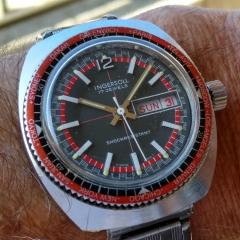Leaderboard
Popular Content
Showing content with the highest reputation on 05/16/18 in all areas
-
Not sure i would recommend that method for this kind of barrel. It may cause the lid to bubble. Same with the valjoux 7750. The lids on these kinds of barrels can be prised off, but do not do it with a screwdriver unless you want to damage the barrel teeth. Honestly, I find it just as easy to prise the lid away with my finger nails, although I am sure that would be frowned upon by some - never ever damaged a barrel that way. I believe Seiko' s idea with this barrel is that it was replaced complete when servicing. I could be wrong but I do not believe a mainspring was available for this movement as a separate part - But a barrel complete rather - if my memory serves me correct. Again, I could be wrong. Sent from my SM-G950F using Tapatalk3 points
-
A spot of 9010 just under the pinion and also on the wider portion of the pivot. "Should any oil be applied to the friction point between the jewel (on the inner/intermediate bridge) and the fourth wheel pinion, and if so what kind of oil?" Yes... D5 - as always, not too much. Sent from my SM-G950F using Tapatalk3 points
-
I’m working myself through Mark Lovic’s “Watch Repair Lessons & Courses”. Before enrolling I wasn’t sure the courses would be worthwhile to me, as I had spent a huge amount of time researching the Internet on how to service watches, and had serviced several Vostok 24XX movements (very affordable movements, BTW). Now, in hindsight, the courses have proved to be extremely valuable to me. I’ve learned things that I just haven’t been able to find elsewhere, like how to easily transfer watch oil from the bottles to the oil pots, how the get the right amount of oil onto the escape wheel teeth, how to remove rust from pinion leaves, that I shouldn’t oil the pallet fork jewel bearings (and why!). The list could be made very long. Anyway, yesterday I finished the level 2 section of the course, named “Lubrication and Re-Assembly”, and as I beheld the magic of seeing the movement come to life again I shoot a slow-motion video of its beating heart, i.e. the balance wheel. For anyone interested you can see the video here. Thanks for reading!1 point
-
I was curious about the specifications so I called a friend Phil. Phil is an interesting person he claims not to be a machinist but machines beautiful things. His fun is to make machinery to make things like clocks or currently make a watch. So when I asked specifications he commented that there is way more to the numbers than just those numbers basically lots of factors that come into play. But we were limited on a phone conversation as he's getting ready to give a talk on his machinery at our local nawcc regional. Then there is the other thing you do need to know how to use your equipment. Not just how to use the equipment but today we can do things differently we can be creative it's the creativity and understanding the equipment that allows you to do things. Having all the super nice precision equipment without the knowledge of what you're trying to do isn't going to let you do it. Then there are other people out there making watches it be nice to find all the links sometimes it's hard to find them they're not always the most visible. Someone gave me this link the other day he is making a watch and is a link to his website at the top where he does talk about is equipment very very briefly unfortunately. https://www.instagram.com/watchmakermike/1 point
-
Very interesting thread going on here. I have been looking on the web trying to find someone who could help and I have come up with this person. From another horology forum, people are extremely happy with his work. http://www.whitescrystals.com/1 point
-
Get a stand support first. That will let do all the work comfortably. As a safety measure place something like sticking rubber or texture tape it on the screw head. Even better, use double side tape as suggested above.1 point
-
That’s nice to know. You can never stop learning. The internet was not around when I was an apprentice. I learned from my master. It just goes to show I’m an old fart. I enjoy the forum so much in helping others with knowledge that I have gained over the years.1 point
-
Yes Mark got me hooked a few years ago. Mind you it has cost a fortune in tools !!!!1 point
-
What makes you think it's a replica ? Don't think that I've seen fake Junghans so far... It's not exactly a very interesting brand... It looks fine to me.1 point
-
A few points to note about " polishing ", if you are trying to remove damage to a casing or bracelet you don't polish it out ( unless very minor scratches ). Polishing is a means to finish a piece, not to repair damage. When you want to remove deep scratches and dents it is called buffing, after you remove the damage and need to finish the metal ( either mirror or satin etc ) it then becomes polishing. It is important to note that when you want to remove damage you don't want to remove the metal you merely want to heat up and manipulate the metal back into the desired shape, almost like moving really hard playdoh. There are several means to achieving the result you need but you must run through some questions to establish how to proceed. 1) What metal am i working with ? Seems obvious enough but each metal reacts differently to different treatments and what works for one may not work for another. Some metals are softer than others ( even between different grades of steel ) so choosing the right product/s for the job will make the result better and also less hard work for you. 2) Is the metal plated or solid ? Sounds obvious again but some casings are made from a base metal ( such as brass ) and then plated ( nickel chrome & gold plating are most common ). Over polishing on these types of casings will result in a rather nasty surprise and a case that will end up worse than when you begin :( If you can establish the casing is plated then the utmost care should be taken in polishing or buffing as removing the plating is all too easy and unsightly damage is even easier still. This isn't to say that plated casings can not be polished back to good order, it just requires a good judgement and experience to know how to proceed. 3) Which compounds / polishing pastes shall i use ? Again this varies depending on the materials hardness and type but luckily there are lots of easily available products that can help to restore that beaten up old casing. There are lots of easily available polishing compounds( dialux, autosol,peek,braso etc ), but if you want to remove deep scratches to Steel/Stainless Steel then id recommend SteelCut by Cannings or similar high/medium grit compound. Steelcut is a high grit compound that will act like sandpaper when used with a rotary tool, but be aware the compound if used too aggressively will easily damage and mis-shapen steel casing & bracelets. The ideal use for this is either via a bench mounted polishing/buffing wheel or a rotary type tool such as a dremel. To apply the compound you would need soft to medium hard felt wheels. The key to removing damage and keeping the original shape comes down to using the correct tool with the correct compound or material and also more importantly....heat. As i said earlier , to remove damage you don't want to remove metal but merely soften the existing metal and manipulate it back to the original shape, this is where heat plays a big role. By using a rotary tool and felt wheel with the right compound ( for example ) you can gently heat the metal up and slowly re shape it back to a smooth finish. The technique is not easy to pick up but with practice you will soon see how metal can be worked. You dont want to press too hard or too softly, and you don't want to keep the felt wheel in the same spot. To retain the casing or bracelets original shape will require learning techniques in buffing ( there are some videos online which can aid you with this ). Fine finishing or mirror polishing is an art form in itself and there are several methods that can be used. Since ive rattled on long enough i will leave a list below of the compounds and products i use for my work, im sure the other guys here will have some great tips of their own :) Removing Damage - SteelCut ( various grits ), Dialux Gris ( Grey ), Abrasive 3M Paper 80-3000 Grit, Silicone Carbide powder, High Micron Diamond paste. General Polishing - Dialux Blue,Red Green , Autosol, Peek, Medium Diamond pastes, Selvet Cloths, High Grit 3M Papers 1200-3000+ Mirror Polishing - Pegwood, Orange Wood, Pith Wood, Beech ( each wood has great polishing properties so experiment ! ), Lavender Oil + Fine Diamond paste 0.25 micron or less, Various Fish Oils, Lavender oil + Flat Zinc plate, Olive Oil , various burnishing tools, polished metal scraps Most important of all .....patience !1 point
-
They probably have enough customers in France, Belgium, Switzerland and Luxembourg Thus, and I hope nobody will take offence about that, with no need of "Rosbifs" or "Rednecks" customers they dont need to use English I'm just kidding of course but to be more serious ... why would they need to use english ,0 points







